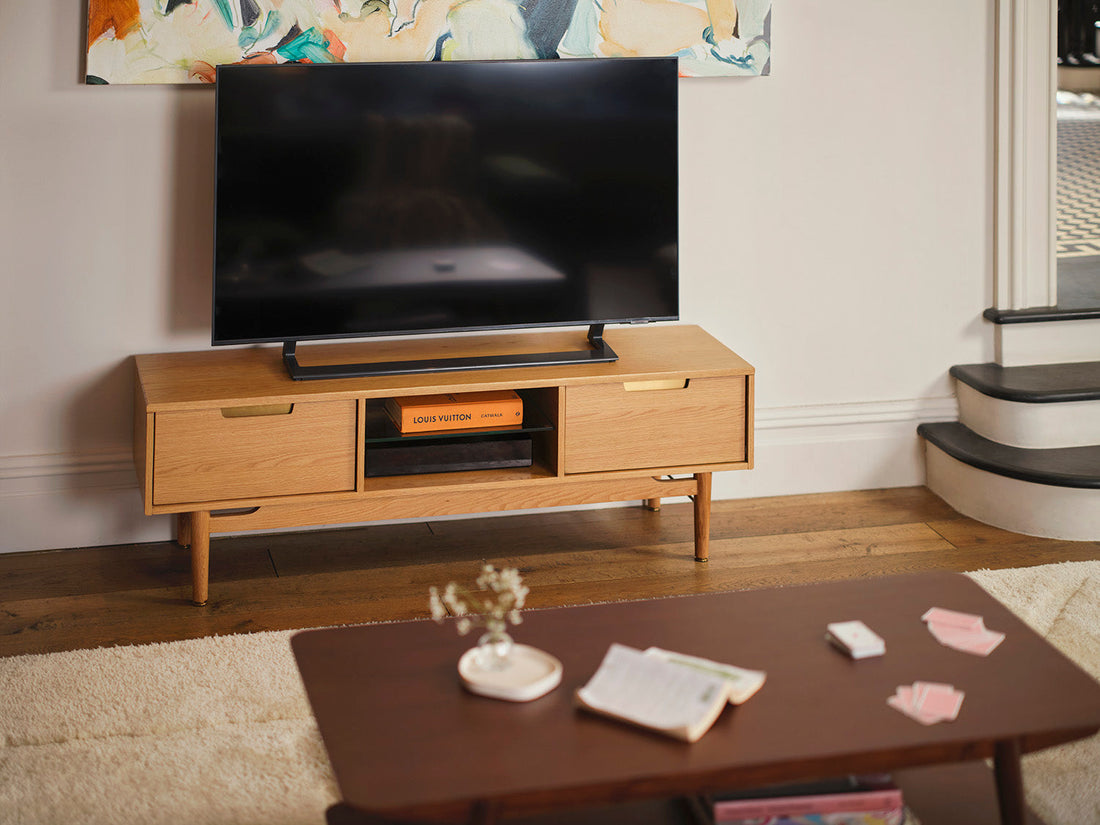How to Choose Between a Wall-Mounted TV and a TV Unit
E
Ed Hawes

Blog Post
GuideLiving Room Ideastranslated-DE
How to Choose Between a Wall-Mounted TV and a TV Unit
E
Ed Hawes
For many of us, our televisions are the focal point of our living rooms. We come together and relax on a big, comfortable sofa to enjoy our favourite shows and movies.
But when planning out a living area, people often raise the same question: Should I hang my TV on the wall, or get a TV unit?
There are pros and cons to each option. And it all depends on the space you have and how you use it.

The pros of a TV unit
- TV units often come with storage, giving you a designated place to stash games, consoles and remote controls.
- It’s easy to hide cords and wires.
- You don’t need to drill holes into your walls like you do with wall-mounted TVs.
- No damage to wallpaper or wall murals.
- Hassle free installation, with no extra fees.
- A TV unit can be another design element to add to your space—helping you create the vibe you desire.
- You can style up a TV unit with other home accessories, like vases or trays.
- You can easily move your TV unit if switching up the layout of your room.
The cons of a TV unit
- TV units take up extra floor space, which can be challenging if you have a small room.
- TV stands don’t allow you to adjust the height of your television.
- TVs aren’t typically strapped onto TV units, so if your TV unit is low to the ground, there’s more risk of it knocking your TV over, or kids pulling it down.
- You will have to consider the size of your TV unit when buying a TV (and vice versa)
The pros of a wall-mounted TV
- Wall-mounted TVs are great for freeing up floor space.
- Easy to hide wires with cable trunking—it just requires some extra installation.
- Wall-mounted TVs are more babyproof as they’re up high and out of reach.
- You can customise the height of your TV.
- With tilted or swivel wall mounts, you can adjust the angle of your TV to reduce glare.
- Articulated wall mounts also allow you to watch the TV from another part of the room—this can be particularly useful if you have an open plan space.
- There are new, ultra-thin wall-mounted TVs that look like picture frames, for a more aesthetically-pleasing finish.
- You can hide your wall-mounted TV in innovative ways—like behind a piece of art, in a cabinet or as part of a gallery wall.
The cons of wall-mounted TV
- Often, people place wall-mounted TVs too high, which can lead to neck strain. There’s even an entire Subreddit about it.
- Wall-mounted TVs require installation and drilling holes into your wall.
- Wall mounts are typically very secure, but on rare occasions, they can fail and drop your TV.
- You have to get the size just right with a wall-mounted TV. Too small a TV can look sparse, but too large a TV can overwhelm a room.

10 questions to ask yourself before choosing a wall-mounted TV or a TV unit
- Do I want the TV to be the focal point of my living room?
- If mounted on the available space on my wall, would it be too high or low?
- Where can I place my TV for minimal glare?
- Do I want my TV to be visible, or do I want to hide it in some way?
- Do I have enough space for another piece of furniture?
- Am I okay with there being holes in the walls?
- What’s the safest option?
- Do I have the right sized TV for the TV unit I want?
- Do I have the right sized TV for hanging on this part of the wall?
- If I did choose a wall-mounted TV, which kind of mount would I get? Fixed, swivel or tilted?
There are benefits to both options—and hey, if you can’t decide, you could always place a TV unit underneath a wall-mounted TV for the best of both worlds.
Still undecided on your TV setup? Learn how to position your TV for the ultimate viewing experience: Find the Perfect Distance Between Your Sofa and TV.
Share
Tags
- Guide
- Living Room Ideas
- translated-DE





